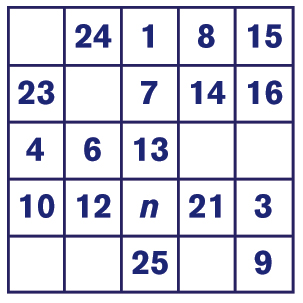
MAGIC SQUARE
The real magic isn't the square...it's how we change minds about math!
MATHCOUNTS provides engaging programs for US middle school students of all ability levels to build confidence and improve attitudes about math and problem solving. Middle school students exist at a critical juncture in which their love for mathematics
must be nurtured or their fear of mathematics must be overcome. MATHCOUNTS programs give students experiences
that foster growth and transcend fear to lay a foundation for future success.
Learn more about how you can support the work we do, register your middle school for our programs or use our incredible math resources.
The magic square shown contains each of the positive integers 1-25. The sum of the numbers in each row, each column and both diagonals is the same. What is the value of n?
Let’s start by finding the sum of the positive integers 1, 2, 3, …, 25. Notice we can pair up the integers into sums of 26: 1 and 25, 2 and 24, 3 and 23, and so on. There are 12 of these pairs, with the integer 13 left in the middle with no partner. The sum of the 25 integers, then, is 26 × 12 + 13 = 312 + 13 = 325. Because each of the five rows must have the same sum, we can determine that sum to be 325 ÷ 5 = 65. Adding the known values in the 4th row, we get 10 + 12 + 21 + 3 = 46. Therefore, the value of n is 65 − 46 = 19.





